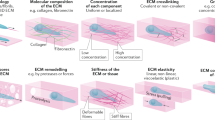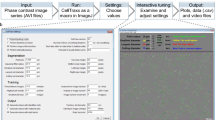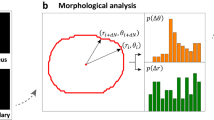Abstract
Cell migration is a key feature of virtually every biological process, and it can be studied in a variety of ways. Here we outline a protocol for the in vitro study of cell migration using a ring barrier–based assay. A 'barrier' is inserted in the culture chamber, which prevents cells from entering a defined area. Cells of interest are seeded around this barrier, and after the formation of a peripheral monolayer the barrier is removed and migration into the cell-free area is monitored. This assay is highly reproducible and convenient to perform, and it allows the deduction of several parameters of migration, including total and effective migration, velocity and cell polarization. An advantage of this assay over the conventional scratch assay is that the cells move over an unaltered and virgin surface, and thus the effect of matrix components on cell migration can be studied. In addition, the cells are not harmed at the onset of the assay. Through computer automation, four individual barrier assays can be monitored at the same time. The procedure can be used in a 12-well standard plate allowing higher throughput, or it can be modified to perform invasion assays. The basic procedure takes 2–3 d to complete.
This is a preview of subscription content, access via your institution
Access options
Subscribe to this journal
Receive 12 print issues and online access
$259.00 per year
only $21.58 per issue
Buy this article
- Purchase on Springer Link
- Instant access to full article PDF
Prices may be subject to local taxes which are calculated during checkout








Similar content being viewed by others
References
Lauffenburger, D.A. & Horwitz, A.F. Cell migration: a physically integrated molecular process. Cell 84, 359–369 (1996).
Horwitz, A.R. & Parsons, J.T. Cell migration–movin' on. Science 286, 1102–1103 (1999).
Ridley, A.J. et al. Cell migration: integrating signals from front to back. Science 302, 1704–1709 (2003).
Petrie, R.J., Doyle, A.D. & Yamada, K.M. Random versus directionally persistent cell migration. Nat. Rev. Mol. Cell Biol. 10, 538–549 (2009).
Trinkaus, J.P. Directional cell movement during early development of the teleost Blennius pholis: I. Formation of epithelial cell clusters and their pattern and mechanism of movement. J. Exp. Zool 245, 157–186 (1988).
Fink, R.D. & Trinkaus, J.P. Fundulus deep cells: directional migration in response to epithelial wounding. Dev. Biol. 129, 179–190 (1988).
Cory, G. Scratch-wound assay. Methods Mol. Biol. 769, 25–30 (2011).
Liang, C.C., Park, A.Y. & Guan, J.L. In vitro scratch assay: a convenient and inexpensive method for analysis of cell migration in vitro. Nat. Protoc. 2, 329–333 (2007).
Qiang, L. et al. Regulation of cell proliferation and migration by p62 through stabilization of Twist1. Proc. Natl. Acad. Sci. USA 111, 9241–9246 (2014).
Varani, J., Orr, W. & Ward, P.A. A comparison of the migration patterns of normal and malignant cells in two assay systems. Am. J. Pathol. 90, 159–172 (1978).
Pratt, B.M., Harris, A.S., Morrow, J.S. & Madri, J.A. Mechanisms of cytoskeletal regulation. Modulation of aortic endothelial cell spectrin by the extracellular matrix. Am. J. Pathol. 117, 349–354 (1984).
Ohtaka, K., Watanabe, S., Iwazaki, R., Hirose, M. & Sato, N. Role of extracellular matrix on colonic cancer cell migration and proliferation. Biochem. Biophys. Res. Commun. 220, 346–352 (1996).
Van Horssen, R. & ten Hagen, T.L. Crossing barriers: the new dimension of 2D cell migration assays. J. Cell Physiol. 226, 288–290 (2011).
van Horssen, R., Galjart, N., Rens, J.A., Eggermont, A.M. & ten Hagen, T.L. Differential effects of matrix and growth factors on endothelial and fibroblast motility: application of a modified cell migration assay. J. Cell Biochem. 99, 1536–1552 (2006).
Bakker, E.R. et al. Wnt5a promotes human colon cancer cell migration and invasion but does not augment intestinal tumorigenesis in Apc1638N mice. Carcinogenesis 34, 2629–2638 (2013).
Das, A.M. et al. Differential TIMP3 expression affects tumor progression and angiogenesis in melanomas through regulation of directionally persistent endothelial cell migration. Angiogenesis 17, 163–177 (2014).
Cheng, C. et al. PDGF-induced migration of vascular smooth muscle cells is inhibited by heme oxygenase-1 via VEGFR2 upregulation and subsequent assembly of inactive VEGFR2/PDGFRβ heterodimers. Arterioscler. Thromb. Vasc. Biol. 32, 1289–1298 (2012).
van Horssen, R. et al. E-cadherin promotor methylation and mutation are inversely related to motility capacity of breast cancer cells. Breast Cancer Res. Treat. 136, 365–377 (2012).
Drabek, K. et al. Role of CLASP2 in microtubule stabilization and the regulation of persistent motility. Curr. Biol. 16, 2259–2264 (2006).
van Horssen, R. et al. Modulation of cell motility by spatial repositioning of enzymatic ATP/ADP exchange capacity. J. Biol. Chem. 284, 1620–1627 (2009).
Kuiper, J.W. et al. Local ATP generation by brain-type creatine kinase (CK-B) facilitates cell motility. PLoS ONE 4, e5030 (2009).
Gorelik, R. & Gautreau, A. Quantitative and unbiased analysis of directional persistence in cell migration. Nat. Protoc. 9, 1931–1943 (2014).
Deforet, M. et al. Automated velocity mapping of migrating cell populations (AVeMap). Nat. Methods 9, 1081–1083 (2012).
Zaritsky, A. et al. Cell motility dynamics: a novel segmentation algorithm to quantify multi-cellular bright-field microscopy images. PLoS ONE 6, e27593 (2011).
Huth, J. et al. Significantly improved precision of cell migration analysis in time-lapse video microscopy through use of a fully automated tracking system. BMC Cell Biol. 11, 24 (2010).
Acknowledgements
We thank A. Brouwer and colleagues of the Erasmus Medical Instrumentation Service for assistance with the development of the migration barriers.
Author information
Authors and Affiliations
Contributions
A.M.D. and T.L.M.t.H. conceived the project. A.M.D. performed experiments and data analysis. A.M.D. and T.L.M.t.H. prepared the figures. A.M.D. wrote the manuscript and A.M.M.E. and T.L.M.t.H. critically revised it.
Corresponding author
Ethics declarations
Competing interests
The authors declare no competing financial interests.
Integrated supplementary information
Supplementary Figure 1 Cell migration barrier.
The cell migration barrier consists of a surgical stainless steel cylinder and a three legged spacer made of polyether ether ketone (PEEK). The basic dimensions of the cell migration barrier are provided.
Supplementary Figure 2 Cell invasion barrier.
The cell invasion barrier consists of a surgical stainless steel cylinder and a three legged spacer made of polyether ether ketone (PEEK). The basic dimensions of the cell invasion barrier are provided.
Supplementary Figure 3 Cell migration unit configurations.
Images of cell migration unit configurations for imaging (a) multiple cell chambers (b) single cell chamber and (c) 12-well plates with the unit components: Cell migration units (1), Cell migration heater (2), Anti-fog glass heater (3), Gas humidifier/heater (4) and suitable microscopes (5).
Supplementary information
Supplementary Text and Figures
Supplementary Figures 1–3 (PDF 122 kb)
Supplementary Manual 1
Interactive PDF of the cell migration barrier. This interactive file can be viewed using Adobe Acrobat XI or Adobe Acrobat Pro. The migration barrier can be viewed in 3D and dimensions measured using the ‘3D measurement tool’ under the ‘Tools’ menu. To access the ‘Tools’ menu, right click on the figure. Scaling, 1 model unit = 1000 mm. (PDF 508 kb)
Supplementary Manual 2
Interactive PDF of the cell invasion barrier. This interactive file can be viewed using Adobe Acrobat XI or Adobe Acrobat Pro. The invasion barrier can be viewed in 3D and dimensions measured using the ‘3D measurement tool’ under the ‘Tools’ menu. To access the ‘Tools’ menu, right click on the figure. Scaling, 1 model unit= 1000 mm. (PDF 500 kb)
Supplementary Data 1
STEP file for migration barrier. (TXT 149 kb)
Supplementary Data 2
IGS file for migration barrier. (TXT 398 kb)
Supplementary Data 3
STEP file for invasion barrier. (TXT 98 kb)
Supplementary Data 4
IGS file for invasion barrier. (TXT 266 kb)
Metastatic melanoma (MM) cell migration on fibronectin coating.
Cell migration was imaged by time-lapse phase-contrast microscopy and an image was collected every 12 min for 16 h. The movie is set to a display rate of 10 frames/s and takes 8s. Original magnification ×10. (MOV 5280 kb)
Non-metastatic melanoma (NM) cell migration on fibronectin coating.
Cell migration was imaged by time-lapse phase-contrast microscopy and an image was collected every 12 min for 16 h. The movie is set to a display rate of 10 frames/s and takes 8s. Original magnification ×10. (MOV 3645 kb)
Rights and permissions
About this article
Cite this article
Das, A., Eggermont, A. & ten Hagen, T. A ring barrier–based migration assay to assess cell migration in vitro. Nat Protoc 10, 904–915 (2015). https://doi.org/10.1038/nprot.2015.056
Published:
Issue Date:
DOI: https://doi.org/10.1038/nprot.2015.056
This article is cited by
-
Nischarin regulates focal adhesion and Invadopodia formation in breast cancer cells
Molecular Cancer (2018)
-
Collective cell migration has distinct directionality and speed dynamics
Cellular and Molecular Life Sciences (2017)
Comments
By submitting a comment you agree to abide by our Terms and Community Guidelines. If you find something abusive or that does not comply with our terms or guidelines please flag it as inappropriate.



